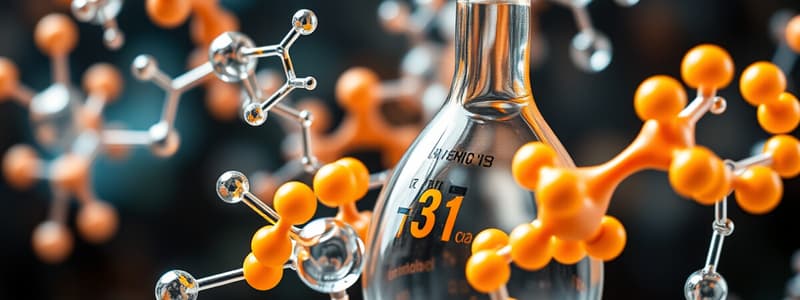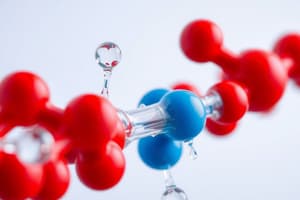Podcast
Questions and Answers
In a solution, the solvent is the:
In a solution, the solvent is the:
- Substance in which the solute is dissolved (correct)
- Substance being dissolved
- Substance that is a gas at room temperature
- Substance that is a solid at room temperature
A solution is a mixture of one or more substances called ____ that are dispersed in a dissolving medium called a ____.
A solution is a mixture of one or more substances called ____ that are dispersed in a dissolving medium called a ____.
- Solvent; solute
- Solute; reactant
- Solute; solvent (correct)
- Reactant; solvent
Which of the following does not affect the rate of molecular collisions?
Which of the following does not affect the rate of molecular collisions?
- Concentration
- Size of molecules (correct)
- Temperature
- Catalysts
Which of the following is a characteristic necessary for all living cells?
Which of the following is a characteristic necessary for all living cells?
In a mixture, if water is the dissolving medium, what type of solution is formed?
In a mixture, if water is the dissolving medium, what type of solution is formed?
What bacterial genus is Mannitol salt agar selective for?
What bacterial genus is Mannitol salt agar selective for?
What type of incubator is most suitable for culturing a pathogen that grows best at human body temperature?
What type of incubator is most suitable for culturing a pathogen that grows best at human body temperature?
Why do bacteria tend to grow fastest when incubated at 37°C?
Why do bacteria tend to grow fastest when incubated at 37°C?
What accurately describes the difference between prokaryotic and eukaryotic organisms?
What accurately describes the difference between prokaryotic and eukaryotic organisms?
Which of the following is not a form of microscopy?
Which of the following is not a form of microscopy?
What does a confocal microscope use to produce a single plane of illumination?
What does a confocal microscope use to produce a single plane of illumination?
Which type of microscope uses an ultraviolet light source?
Which type of microscope uses an ultraviolet light source?
Which microscopy technique allows for visualization of larger viruses using an electron microscope?
Which microscopy technique allows for visualization of larger viruses using an electron microscope?
What is the purpose of immersion oil in light microscopy?
What is the purpose of immersion oil in light microscopy?
Which of the following does not describe the classification of media based on its consistency?
Which of the following does not describe the classification of media based on its consistency?
Which of the following molecules serves as the building blocks of proteins?
Which of the following molecules serves as the building blocks of proteins?
What is the bond formed between the building blocks of proteins called?
What is the bond formed between the building blocks of proteins called?
Which type of medium is used to promote the growth of specific microorganisms by inhibiting others?
Which type of medium is used to promote the growth of specific microorganisms by inhibiting others?
All of the following are components of a nucleotide except:
All of the following are components of a nucleotide except:
What is the most likely reason a microbiologist finds both Staphylococcus aureus and Staphylococcus epidermidis growing in a culture?
What is the most likely reason a microbiologist finds both Staphylococcus aureus and Staphylococcus epidermidis growing in a culture?
Which of the following is true about RNA molecules compared to DNA molecules?
Which of the following is true about RNA molecules compared to DNA molecules?
Which of the following molecules is formed by three fatty acids attached to a glycerol?
Which of the following molecules is formed by three fatty acids attached to a glycerol?
A reducing medium is characterized by which of the following?
A reducing medium is characterized by which of the following?
What type of structural feature do the α-helix and the β-pleated sheet represent in proteins?
What type of structural feature do the α-helix and the β-pleated sheet represent in proteins?
What is the most effective sterilizing condition in a steam autoclave?
What is the most effective sterilizing condition in a steam autoclave?
Which type of medium is specifically designed to distinguish between different species based on observable changes?
Which type of medium is specifically designed to distinguish between different species based on observable changes?
What is a pure culture defined as?
What is a pure culture defined as?
Which of the following is NOT a functional group found in organic compounds?
Which of the following is NOT a functional group found in organic compounds?
Which microorganism is primarily cultured in a medium containing bile salts?
Which microorganism is primarily cultured in a medium containing bile salts?
Which of the following bonds holds the double-stranded structure of DNA together?
Which of the following bonds holds the double-stranded structure of DNA together?
Flashcards are hidden until you start studying
Study Notes
Chemistry of Biology
- Solvent is the substance in which the solute is dissolved.
- A solution consists of solutes dispersed in a solvent.
- The rate of molecular collisions is influenced by temperature, catalysts, concentration, and size of molecules.
- All living cells contain carbon, nitrogen, oxygen, and hydrogen.
- Common organic molecules in cells include carbohydrates, lipids, proteins, and nucleic acids.
- Enzymes are composed of amino acids.
- Carbohydrates are built from monosaccharides.
- Proteins are connected by peptide bonds.
- A triglyceride consists of glycerol bonded to three fatty acids.
- Nucleotides are made of a phosphate, a sugar, and a nitrogen base.
- Secondary structures of proteins include α-helix and β-pleated sheets.
- Functional groups in organic compounds include carboxyl, amino, phosphate, and hydroxyl groups.
- RNA differs from DNA by having ribose, uracil, being typically single-stranded, and lacking thymine.
- Phosphate and sugar in DNA backbone are connected by phosphodiester bonds.
- Amino acids are the subunits of proteins.
- The strands of DNA are held together by hydrogen bonds.
- RNA contains ribose; DNA does not.
- In DNA, guanine pairs with cytosine.
- DNA, RNA, and ATP all contain phosphate and are made of nucleotides.
Tools of the Laboratory
- Culture refers to the growth of microorganisms in media.
- Development of discrete colonies requires solid medium.
- Agar is a complex polysaccharide obtained from algae.
- If both Staphylococcus aureus and Staphylococcus epidermidis grow in a culture, it is likely contaminated.
- A pure culture contains only one species of microorganism.
- A subculture is derived from an isolated colony.
- Pour plate method allows for colonies developing throughout the agar.
- Optimal sterilizing conditions in a steam autoclave are 121°C at 15 psi for 15 minutes.
- A reducing medium contains substances that remove oxygen.
- Selective media for fecal specimens may contain bile salts.
- Fastidious bacteria require special growth factors and complex organic substances.
- Differential media reveal variations in colony color or appearance.
- A nutrient medium with thioglycollic acid indicates an attempt to culture anaerobes.
- Differential media distinguish between different microbial species based on observable changes.
- Mannitol salt agar selectively promotes the growth of Staphylococcus.
- Incubators for pathogens growing at body temperature should maintain 37°C.
- Bacteria grow fastest at 37°C due to optimal enzyme and protein function.
- Prokaryotic organisms lack a nucleus, while eukaryotic organisms possess one.
- Microscopy includes techniques like bright-field, phase-contrast, and fluorescence.
- A confocal microscope uses visible light for single-plane illumination.
- Fluorescence microscopy employs ultraviolet light to visualize cellular structures.
- Transmission electron microscopy (TEM) visualizes cell structures and larger viruses.
- Electron microscopes provide highest magnification and resolution.
- Immersion oil in microscopy increases light capturing capabilities.
- Staining techniques such as Gram stain are classified as differential staining methods.
- Dyes used in microbiological stains can be cationic or anionic.
- Simple staining provides information on cell shape, size, and arrangement.
- Classification of media includes liquid, solid, semi-solid, and differential types.
- Mannitol salt agar serves as a selective medium for specific bacterial species.
Studying That Suits You
Use AI to generate personalized quizzes and flashcards to suit your learning preferences.


